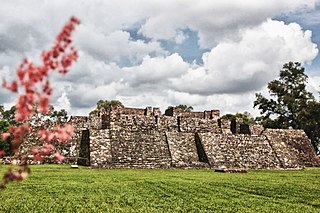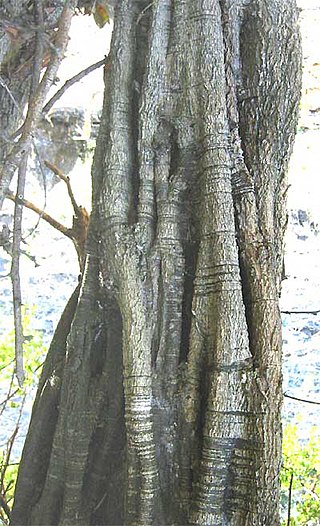
Quetzals are strikingly colored birds in the trogon family. They are found in forests, especially in humid highlands, with the five species from the genus Pharomachrus being exclusively Neotropical, while a single species, the eared quetzal, Euptilotis neoxenus, is found in Guatemala, sometimes in Mexico and very locally in the southernmost United States. In the highlands of the states of Sonora, Chihuahua, Sinaloa, Durango, Nayarit, Zacatecas, Jalisco, and Michoacán, the eared quetzal can be found from northwest to west-central Mexico. It is a Mesoamerican indigenous species, but some reports show that it occasionally travels and nests in southeastern Arizona and New Mexico in the United States. June to October is the mating season for eared quetzals. Quetzals are fairly large, slightly bigger than other trogon species. The resplendent quetzal is the national bird of Guatemala because of its vibrant colour and cultural significance to the Maya.

Monstera deliciosa, the Swiss cheese plant or split-leaf philodendron is a species of flowering plant native to tropical forests of southern Mexico, south to Panama. It has been introduced to many tropical areas, and has become a mildly invasive species in Hawaii, Seychelles, Ascension Island and the Society Islands. It is very widely grown in temperate zones as a houseplant.

Taxodium mucronatum, commonly known as Montezuma bald cypress, Montezuma cypress, or ahuehuete, is a species of Taxodium that is primarily native to Mexico and Guatemala, with a few populations in the southwestern United States. Ahuehuete is derived from the Nahuatl name for the tree, āhuēhuētl, which means "upright drum in water" or "old man of the water."

Plumeria, also known as frangipani, is a genus of flowering plants in the subfamily Rauvolfioideae, of the family Apocynaceae. Most species are deciduous shrubs or small trees. The species are native to the Neotropical realm, but are often grown as cosmopolitan ornamentals in tropical regions, especially in Hawaii, as well as hot desert climates in the Arabian Peninsula with proper irrigation.

Digitalis purpurea, the foxglove or common foxglove, is a toxic species of flowering plant in the plantain family Plantaginaceae, native to, and also widespread throughout most of temperate Europe. It has also naturalized in parts of North America, as well as some other temperate regions. The plant is a popular garden subject, with many cultivars available. It is the original source of the medicine digoxin, a medicine for the human heart. This biennial plant grows as a rosette of leaves in the first year after sowing, before flowering and then dying in the second year. It generally produces enough seeds, however, so that new plants will continue to grow in a garden setting.
Magnolia guatemalensis is a tree found in the highlands and mountains of Guatemala, Chiapas, El Salvador, and Honduras. It is considered an indicator species of the cloud forest.

Spondias purpura is a species of flowering plant in the cashew family, Anacardiaceae, that is native to tropical regions of the Americas, from Mexico to northern Colombia and the southwest Caribbean Islands. It has also been introduced to and naturalized to other parts of the American tropics, Southeast Asia, and West Africa. It is commonly known as jocote, which derives from the Nahuatl word xocotl, meaning any kind of sour or acidic fruit. Other common names include red mombin, Spanish plum, purple mombin, Jamaica plum, and hog plum.

Tagetes erecta, the Aztec marigold, Mexican marigold, big marigold, cempaxochitl or cempasúchil, is a species of flowering plant in the genus Tagetes native to Mexico and Guatemala. Despite being native to the Americas, it is often called the African marigold. In Mexico, this plant is found in the wild in the states of México, Michoacán, Puebla, Veracruz and Guerrero.

The ancient Aztecs employed a variety of entheogenic plants and animals within their society. The various species have been identified through their depiction on murals, vases, and other objects.

Brosimum alicastrum, commonly known as breadnut, Maya nut or ramon, and many others, is a tree species in the family Moraceae of flowering plants, whose other genera include figs and mulberries. The plant is known by a range of names in indigenous Mesoamerican and other languages, including: ojoche, ojite, ojushte, ujushte, ujuxte, capomo, mojo, ox, iximche, masica in Honduras, uje in the state of Michoacan Mexico, mojote in Jalisco, chokogou in Haitian Creole and chataigne in Trinidadian Creole. In the Caribbean coast of Colombia it is called guaímaro or guaymaro.

Ulmus mexicana, the Mexican elm, is a large tree endemic to Mexico and Central America. It is most commonly found in cloud forest and the higher elevations of tropical rain forest with precipitation levels of 2–4 m (79–157 in) per year, ranging from San Luis Potosi south to Chiapas in Mexico, and from Guatemala to Panama beyond. The tree was first described botanically in 1873.

Magnolia dealbata is a species of flowering plant in the family Magnoliaceae, native to Mexico. It is known commonly as the cloudforest magnolia and eloxochitl. It is sometimes considered to be a subspecies of Magnolia macrophylla, which is otherwise native to the southeastern United States.

Plumeria rubra is a deciduous plant species belonging to the genus Plumeria. Originally native to Mexico, Central America, Colombia and Venezuela, it has been widely cultivated in subtropical and tropical climates worldwide and is a popular garden and park plant, as well as being used in temples and cemeteries. It grows as a spreading tree to 7–8 m (23–26 ft) high and wide, and is flushed with fragrant flowers of shades of pink, white and yellow over the summer and autumn.
Ficus maxima is a fig tree which is native to Mexico, Central America, the Caribbean and South America south to Paraguay. Figs belong to the family Moraceae. The specific epithet maxima was coined by Scottish botanist Philip Miller in 1768; Miller's name was applied to this species in the Flora of Jamaica, but it was later determined that Miller's description was actually of the species now known as Ficus aurea. To avoid confusion, Cornelis Berg proposed that the name should be conserved for this species. Berg's proposal was accepted in 2005.

Gliricidia sepium, often simply referred to as gliricidia or by its Spanish common name madre de cacao, is a medium size leguminous tree belonging to the family Fabaceae. It is an important multi-purpose legume tree, with a native range from Mexico to Colombia, but now widely introduced to other tropical zones.

Crataegus mexicana is a species of hawthorn known by the common names tejocote, manzanita, tejocotera and Mexican hawthorn. It is native to the mountains of Mexico and parts of Guatemala, and has been introduced in the Andes. The fruit of this species is one of the most useful among hawthorns.

Haematoxylum brasiletto, or Mexican logwood, is a species of tropical hardwood tree in the legume family, Fabaceae. It is known in its native Mexico and Guatemala as "palo de brasil" or "palo de tinto". The timber is used to make bows for stringed instruments, the manufacture of dyes and in ethnobotany.

Pouteria viridis is a species of flowering plant in the family Sapotaceae known by the common name green sapote.

Quercus castanea is a species of oak tree. It is widespread across much of Mexico, from Sonora to Chiapas, and in Guatemala, El Salvador, and Honduras.

The Sierra Madre de Chiapas moist forests is a tropical moist broadleaf forest ecoregion in southern Mexico and southern Guatemala, extending into the northwestern corner of El Salvador.


















